Graph Attention Informer for Long-Term Traffic Flow Prediction under the Impact of Sports Events
Abstract
1. Introduction
- To the best of our knowledge, this is the first study to consider the impact of major sports events in traffic flow prediction.
- The Graph Attention Informer (GAT-Informer) structure is firstly proposed to address the long-term traffic flow prediction problem by combining the Graph Attention Network and the Informer Network.
- In addition to using the classical dataset, another dataset used to verify and test GAT-Informer is newly collected real-world data containing real sports events. This dataset has not been applied to other published articles.
2. Related Research
2.1. Problem Statement
2.2. Classical Prediction Model
2.3. Deep Learning-Based Prediction Model
3. Methodology
3.1. Problem Formulation
3.2. Definition of Sports Events Impact Factor
3.3. GAT-Informer Architecture
3.3.1. Graph Attention Layer
3.3.2. Informer Layer
3.3.3. Loss Function
4. Experiment and Analysis
4.1. Dataset and Preprocessing
4.1.1. PeMS04 Dataset
4.1.2. London Dataset
4.1.3. Data Preprocessing
4.2. Experimental Verification
4.2.1. Evaluation Metrics
4.2.2. Experiment Settings
4.2.3. Experimental Results
- GRU: The GRU is a variant model of RNN. It has been proven to be effective in the short-term time series forecasting problems, and the model also stands out for its ability to alleviate the gradient explosion and vanishing problem. However, the GRU is less effective in the scenario of long-term prediction.
- T-GCN: The Integrated GCN and GRU capture both spatial and temporal correlation, and they can be used for both short-term and long-term traffic prediction [42]. However, similar to recurrent-based temporal information, their extraction capacity is weak in long-term prediction.
- Informer: The Informer model addresses the computational cost and memory usage problem of the Transformer. The model is widely used in short-term or long-term traffic prediction, but it cannot extract information from adjacent nodes.
- ASTGCN: The ASTGCN model is designed for traffic prediction that excels in capturing spatial and temporal dependencies [35]. The novel spatial–temporal attention mechanism enables the model to achieve high performance in traffic prediction. However, this model is constrained by the static map and cannot incorporate external factors.
- ASTGNN: The ASTGNN model is an attention-based spatial–temporal model, which stands out for the novel design of a special self-attention mechanism [43]. In both of the short-term and long-term prediction scenarios, the model can achieve satisfying performance.
4.2.4. Evaluation of Arrival and Depature Redundancy
4.2.5. Results Visualization
5. Conclusions
Author Contributions
Funding
Institutional Review Board Statement
Informed Consent Statement
Data Availability Statement
Conflicts of Interest
References
- Qureshi, K.N.; Abdullah, A.H. A survey on intelligent transportation systems. Middle-East J. Sci. Res. 2013, 15, 629–642. [Google Scholar]
- Nagy, A.M.; Simon, V. Survey on traffic prediction in smart cities. Pervasive Mob. Comput. 2018, 50, 148–163. [Google Scholar] [CrossRef]
- Yang, H.F.; Dillon, T.S.; Chen, Y.P.P. Optimized structure of the traffic flow forecasting model with a deep learning approach. IEEE Trans. Neural Netw. Learn. Syst. 2016, 28, 2371–2381. [Google Scholar] [CrossRef]
- Xie, P.; Li, T.; Liu, J.; Du, S.; Yang, X.; Zhang, J. Urban flow prediction from spatiotemporal data using machine learning: A survey. Inf. Fusion 2020, 59, 1–12. [Google Scholar] [CrossRef]
- Zhang, J.; Wang, F.Y.; Wang, K.; Lin, W.H.; Xu, X.; Chen, C. Data-driven intelligent transportation systems: A survey. IEEE Trans. Intell. Transp. Syst. 2011, 12, 1624–1639. [Google Scholar] [CrossRef]
- Ben-Akiva, M.E.; Gao, S.; Wei, Z.; Wen, Y. A dynamic traffic assignment model for highly congested urban networks. Transp. Res. Part C Emerg. Technol. 2012, 24, 62–82. [Google Scholar] [CrossRef]
- Wu, Y.; Tan, H.; Qin, L.; Ran, B.; Jiang, Z. A hybrid deep learning based traffic flow prediction method and its understanding. Transp. Res. Part C Emerg. Technol. 2018, 90, 166–180. [Google Scholar] [CrossRef]
- Jain, V.; Sharma, A.; Subramanian, L. Road traffic congestion in the developing world. In Proceedings of the 2nd ACM Symposium on Computing for Development, Atlanta, GA, USA, 11–12 March 2012; pp. 1–10. [Google Scholar]
- Luo, R.; Zhang, Y.; Zhou, Y.; Chen, H.; Yang, L.; Yang, J.; Su, R. Deep learning approach for long-term prediction of electric vehicle (ev) charging station availability. In Proceedings of the 2021 IEEE International Intelligent Transportation Systems Conference (ITSC), Indianapolis, IN, USA, 19–22 September 2021; IEEE: Pistcataway, NJ, USA, 2021; pp. 3334–3339. [Google Scholar]
- Bovy, P. Mega sports event transportation and main mobility management issues. In Proceedings of the Transport and Exceptional Public Events, Report of the One Hundred and Twenty Second Round Table on Transport Economics, Paris, France, 7–8 March 2002; European Conference of Ministers of Transport: Brussels, Belgium, 2003. [Google Scholar]
- Kim, W.; Jun, H.M.; Walker, M.; Drane, D. Evaluating the perceived social impacts of hosting large-scale sport tourism events: Scale development and validation. Tour. Manag. 2015, 48, 21–32. [Google Scholar] [CrossRef]
- Zhu, L.; Yu, F.R.; Wang, Y.; Ning, B.; Tang, T. Big data analytics in intelligent transportation systems: A survey. IEEE Trans. Intell. Transp. Syst. 2018, 20, 383–398. [Google Scholar] [CrossRef]
- Yin, X.; Wu, G.; Wei, J.; Shen, Y.; Qi, H.; Yin, B. Deep learning on traffic prediction: Methods, analysis, and future directions. IEEE Trans. Intell. Transp. Syst. 2021, 23, 4927–4943. [Google Scholar] [CrossRef]
- Pan, B.; Demiryurek, U.; Shahabi, C. Utilizing real-world transportation data for accurate traffic prediction. In Proceedings of the 2012 IEEE 12th International Conference on Data Mining, Brussels, Belgium, 10–13 December 2012; IEEE: Piscataway, NJ, USA, 2012; pp. 595–604. [Google Scholar]
- Box, G.E.; Jenkins, G.M.; Reinsel, G.C.; Ljung, G.M. Time Series Analysis: Forecasting and Control; John Wiley & Sons: Hoboken, NJ, USA, 2015. [Google Scholar]
- Okutani, I.; Stephanedes, Y.J. Dynamic prediction of traffic volume through Kalman filtering theory. Transp. Res. Part B Methodol. 1984, 18, 1–11. [Google Scholar] [CrossRef]
- Feng, X.; Ling, X.; Zheng, H.; Chen, Z.; Xu, Y. Adaptive multi-kernel SVM with spatial–Temporal correlation for short-term traffic flow prediction. IEEE Trans. Intell. Transp. Syst. 2018, 20, 2001–2013. [Google Scholar] [CrossRef]
- Cai, P.; Wang, Y.; Lu, G.; Chen, P.; Ding, C.; Sun, J. A spatiotemporal correlative k-nearest neighbor model for short-term traffic multistep forecasting. Transp. Res. Part C Emerg. Technol. 2016, 62, 21–34. [Google Scholar] [CrossRef]
- Qi, Y.; Ishak, S. A Hidden Markov Model for short term prediction of traffic conditions on freeways. Transp. Res. Part C Emerg. Technol. 2014, 43, 95–111. [Google Scholar] [CrossRef]
- Zhang, W.; Yu, Y.; Qi, Y.; Shu, F.; Wang, Y. Short-term traffic flow prediction based on spatio-temporal analysis and CNN deep learning. Transp. A Transp. Sci. 2019, 15, 1688–1711. [Google Scholar] [CrossRef]
- Ramakrishnan, N.; Soni, T. Network traffic prediction using recurrent neural networks. In Proceedings of the 2018 17th IEEE International Conference on Machine Learning and Applications (ICMLA), Orlando, FL, USA, 17–20 December 2018; IEEE: Piscataway, NJ, USA, 2018; pp. 187–193. [Google Scholar]
- Yu, B.; Lee, Y.; Sohn, K. Forecasting road traffic speeds by considering area-wide spatio-temporal dependencies based on a graph convolutional neural network (GCN). Transp. Res. Part C Emerg. Technol. 2020, 114, 189–204. [Google Scholar] [CrossRef]
- Fu, R.; Zhang, Z.; Li, L. Using LSTM and GRU neural network methods for traffic flow prediction. In Proceedings of the 2016 31st Youth Academic Annual Conference of Chinese Association Of Automation (YAC), Wuhan, China, 11–13 November 2016; IEEE: Piscataway, NJ, USA, 2016; pp. 324–328. [Google Scholar]
- Zhao, Z.; Chen, W.; Wu, X.; Chen, P.C.; Liu, J. LSTM network: A deep learning approach for short-term traffic forecast. IET Intell. Transp. Syst. 2017, 11, 68–75. [Google Scholar] [CrossRef]
- Gomes, B.; Coelho, J.; Aidos, H. A survey on traffic flow prediction and classification. Intell. Syst. Appl. 2023, 20, 200268. [Google Scholar] [CrossRef]
- Yu, B.; Yin, H.; Zhu, Z. Spatio-temporal graph convolutional networks: A deep learning framework for traffic forecasting. arXiv 2017, arXiv:1709.04875. [Google Scholar]
- Xu, M.; Dai, W.; Liu, C.; Gao, X.; Lin, W.; Qi, G.J.; Xiong, H. Spatial-temporal transformer networks for traffic flow forecasting. arXiv 2020, arXiv:2001.02908. [Google Scholar]
- Qu, L.; Li, W.; Li, W.; Ma, D.; Wang, Y. Daily long-term traffic flow forecasting based on a deep neural network. Expert Syst. Appl. 2019, 121, 304–312. [Google Scholar] [CrossRef]
- Zhang, G.P. Time series forecasting using a hybrid ARIMA and neural network model. Neurocomputing 2003, 50, 159–175. [Google Scholar] [CrossRef]
- Williams, B.M.; Hoel, L.A. Modeling and forecasting vehicular traffic flow as a seasonal ARIMA process: Theoretical basis and empirical results. J. Transp. Eng. 2003, 129, 664–672. [Google Scholar] [CrossRef]
- Lee, S.; Fambro, D.B. Application of subset autoregressive integrated moving average model for short-term freeway traffic volume forecasting. Transp. Res. Rec. 1999, 1678, 179–188. [Google Scholar] [CrossRef]
- Shu, Y.; Jin, Z.; Zhang, L.; Wang, L.; Yang, O.W. Traffic prediction using FARIMA models. In Proceedings of the 1999 IEEE International Conference on Communications (Cat. No. 99CH36311), Vancouver, BC, Canada, 6–10 June 1999; IEEE: Piscataway, NJ, USA, 1999; Volume 2, pp. 891–895. [Google Scholar]
- Vaswani, A.; Shazeer, N.; Parmar, N.; Uszkoreit, J.; Jones, L.; Gomez, A.N.; Kaiser, Ł.; Polosukhin, I. Attention is all you need. Adv. Neural Inf. Process. Syst. 2017, 30. [Google Scholar]
- Ali, A.; Zhu, Y.; Zakarya, M. Exploiting dynamic spatio-temporal graph convolutional neural networks for citywide traffic flows prediction. Neural Netw. 2022, 145, 233–247. [Google Scholar] [CrossRef] [PubMed]
- Guo, S.; Lin, Y.; Feng, N.; Song, C.; Wan, H. Attention based spatial-temporal graph convolutional networks for traffic flow forecasting. In Proceedings of the AAAI Conference on Artificial Intelligence, Honolulu, HI, USA, 27 January–1 February 2019; Volume 33, pp. 922–929. [Google Scholar]
- Zheng, C.; Fan, X.; Wang, C.; Qi, J. Gman: A graph multi-attention network for traffic prediction. In Proceedings of the AAAI Conference on Artificial Intelligence, New York, NY, USA, 7–12 February 2020; Volume 34, pp. 1234–1241. [Google Scholar]
- Han, L.; Du, B.; Sun, L.; Fu, Y.; Lv, Y.; Xiong, H. Dynamic and multi-faceted spatio-temporal deep learning for traffic speed forecasting. In Proceedings of the 27th ACM SIGKDD Conference on Knowledge Discovery & Data Mining, Virtual, 14–18 August 2021; pp. 547–555. [Google Scholar]
- Li, M.; Zhu, Z. Spatial-temporal fusion graph neural networks for traffic flow forecasting. In Proceedings of the AAAI Conference on Artificial Intelligence, Virtual, 2–9 February 2021; Volume 35, pp. 4189–4196. [Google Scholar]
- Jiang, W.; Luo, J. Graph neural network for traffic forecasting: A survey. Expert Syst. Appl. 2022, 207, 117921. [Google Scholar] [CrossRef]
- Veličković, P.; Cucurull, G.; Casanova, A.; Romero, A.; Lio, P.; Bengio, Y. Graph attention networks. arXiv 2017, arXiv:1710.10903. [Google Scholar]
- Zhou, H.; Zhang, S.; Peng, J.; Zhang, S.; Li, J.; Xiong, H.; Zhang, W. Informer: Beyond efficient transformer for long sequence time-series forecasting. In Proceedings of the AAAI Conference on Artificial Intelligence, Virtual, 2–9 February 2021; Volume 35, pp. 11106–11115. [Google Scholar]
- Zhao, L.; Song, Y.; Zhang, C.; Liu, Y.; Wang, P.; Lin, T.; Deng, M.; Li, H. T-gcn: A temporal graph convolutional network for traffic prediction. IEEE Trans. Intell. Transp. Syst. 2019, 21, 3848–3858. [Google Scholar] [CrossRef]
- Guo, S.; Lin, Y.; Wan, H.; Li, X.; Cong, G. Learning dynamics and heterogeneity of spatial-temporal graph data for traffic forecasting. IEEE Trans. Knowl. Data Eng. 2021, 34, 5415–5428. [Google Scholar] [CrossRef]




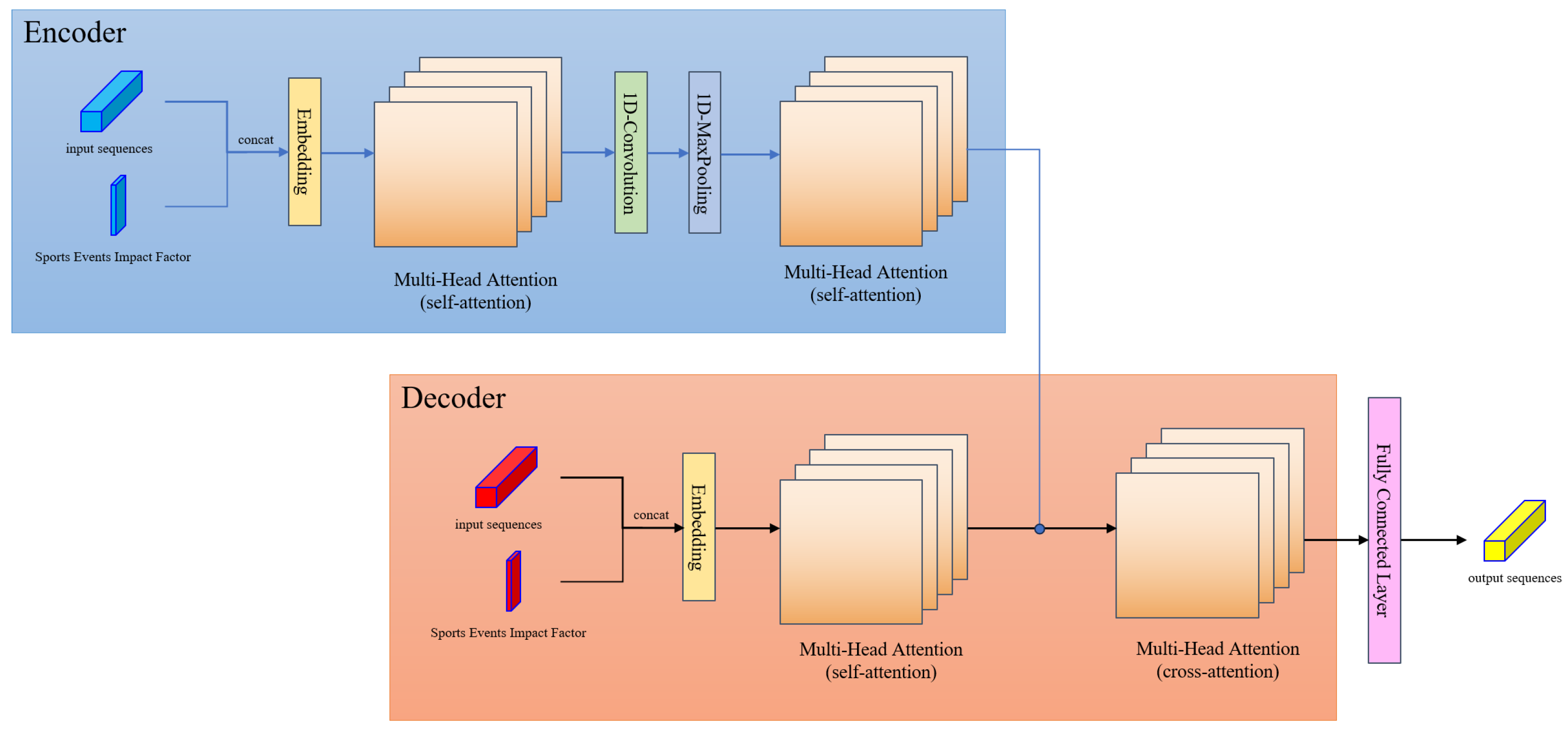
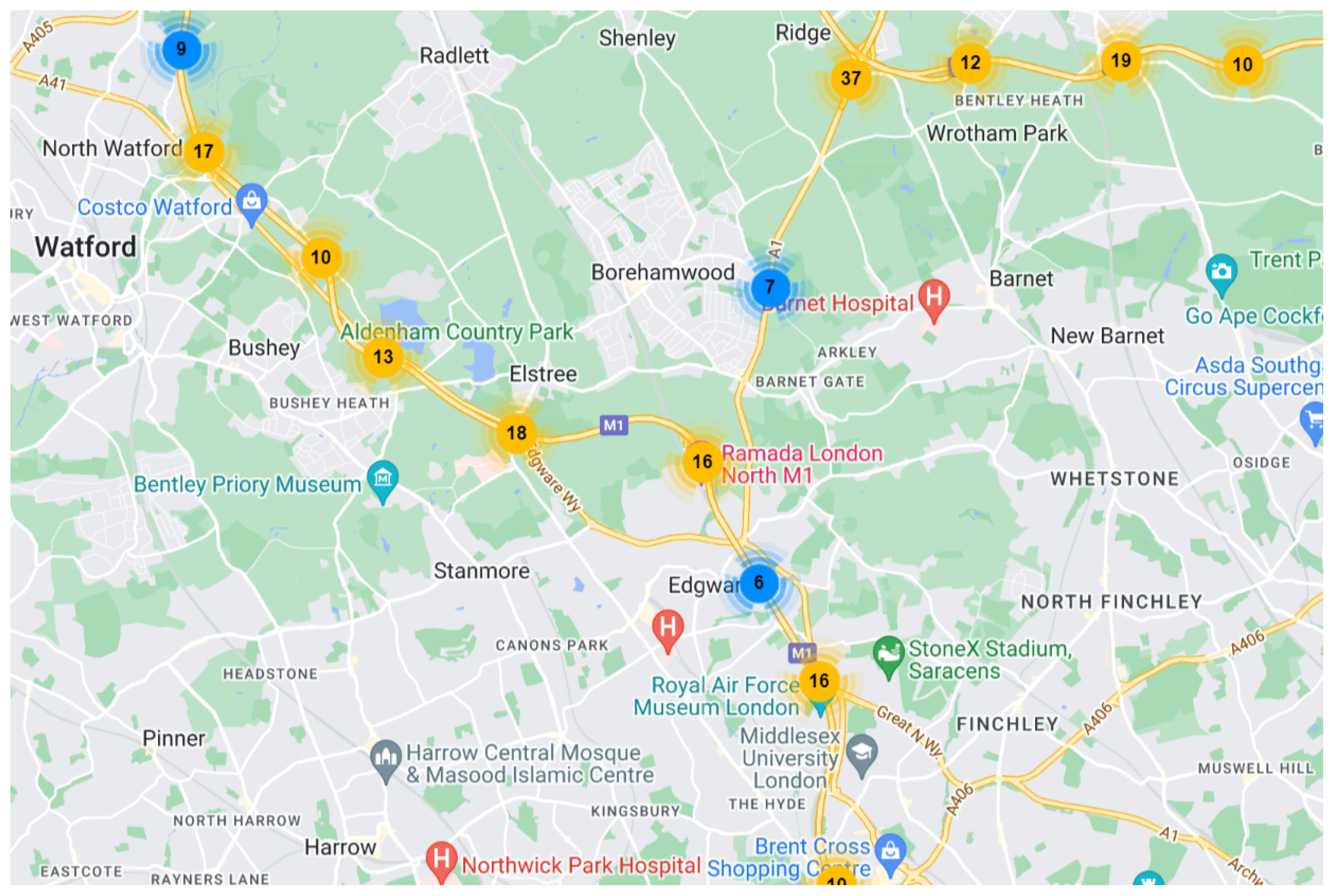

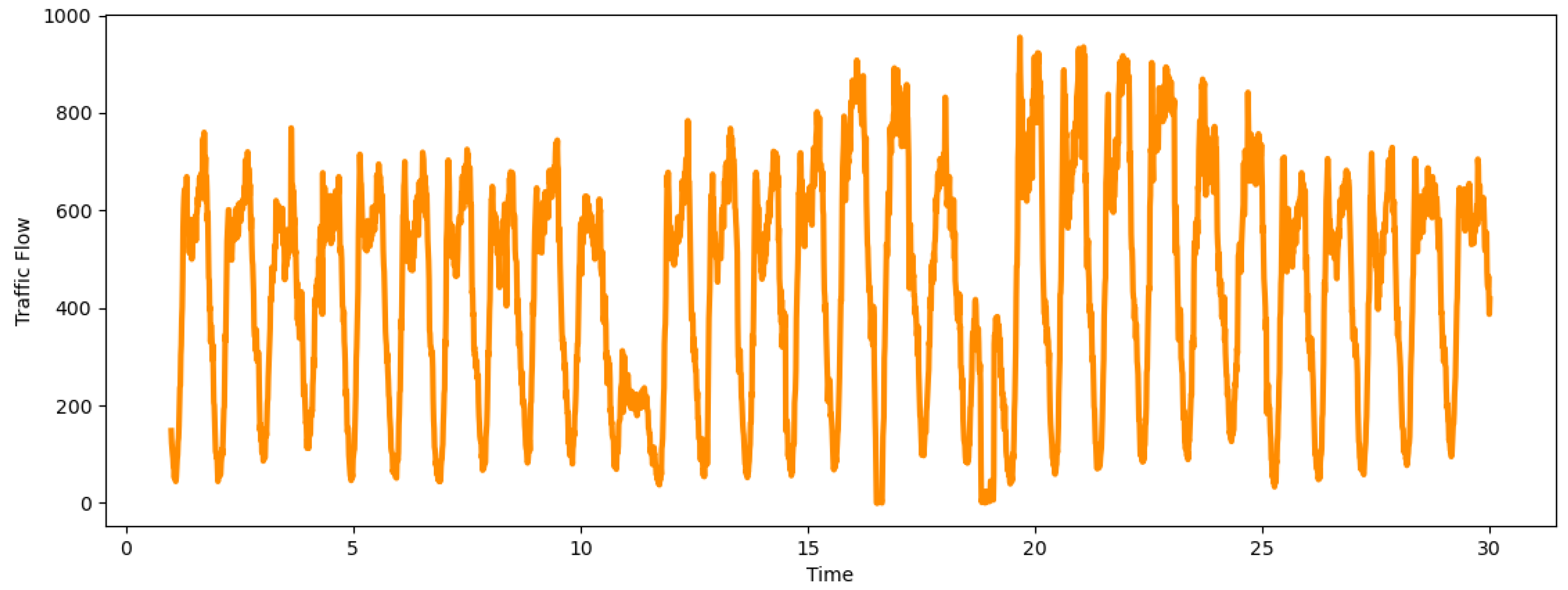
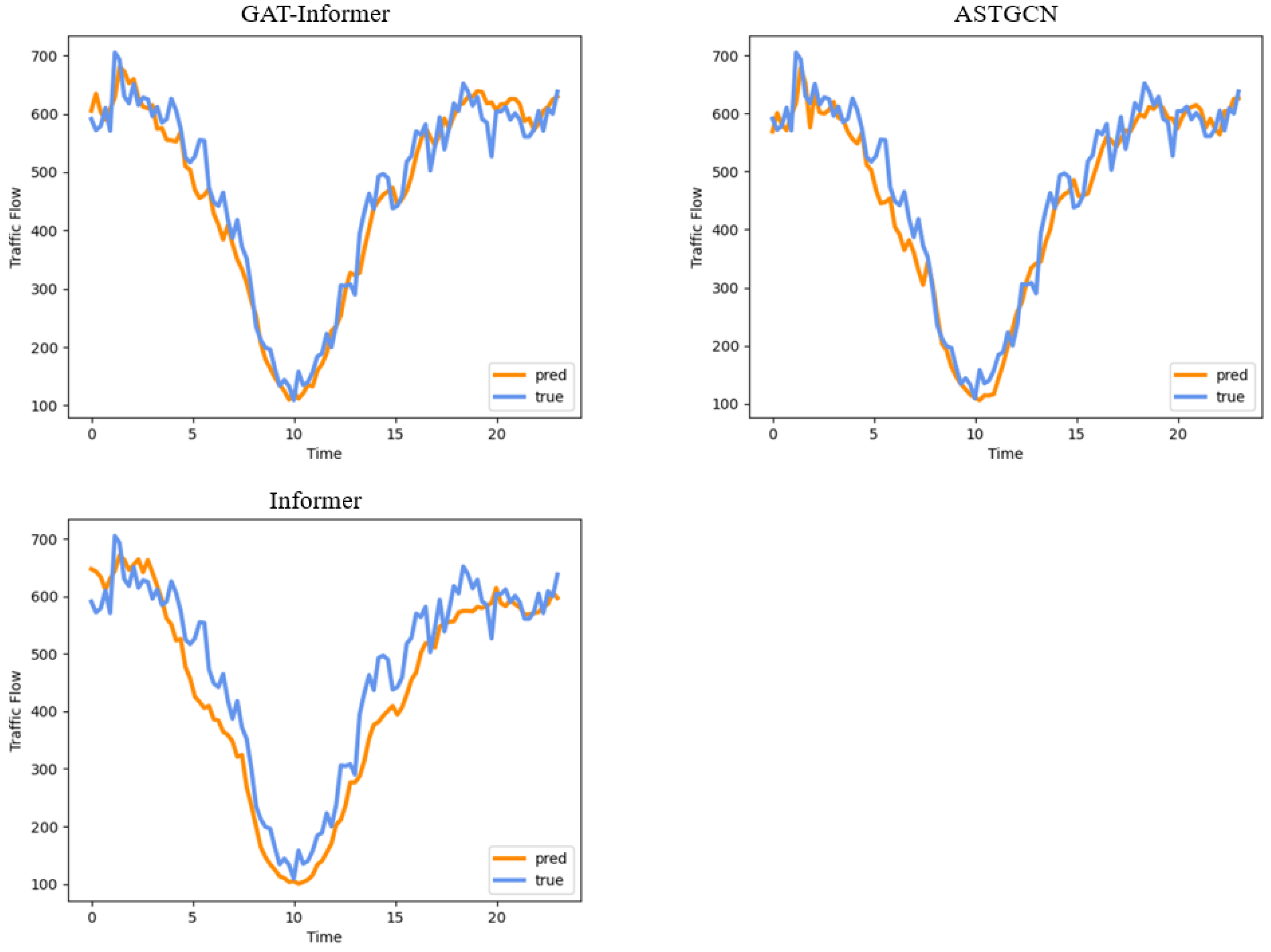
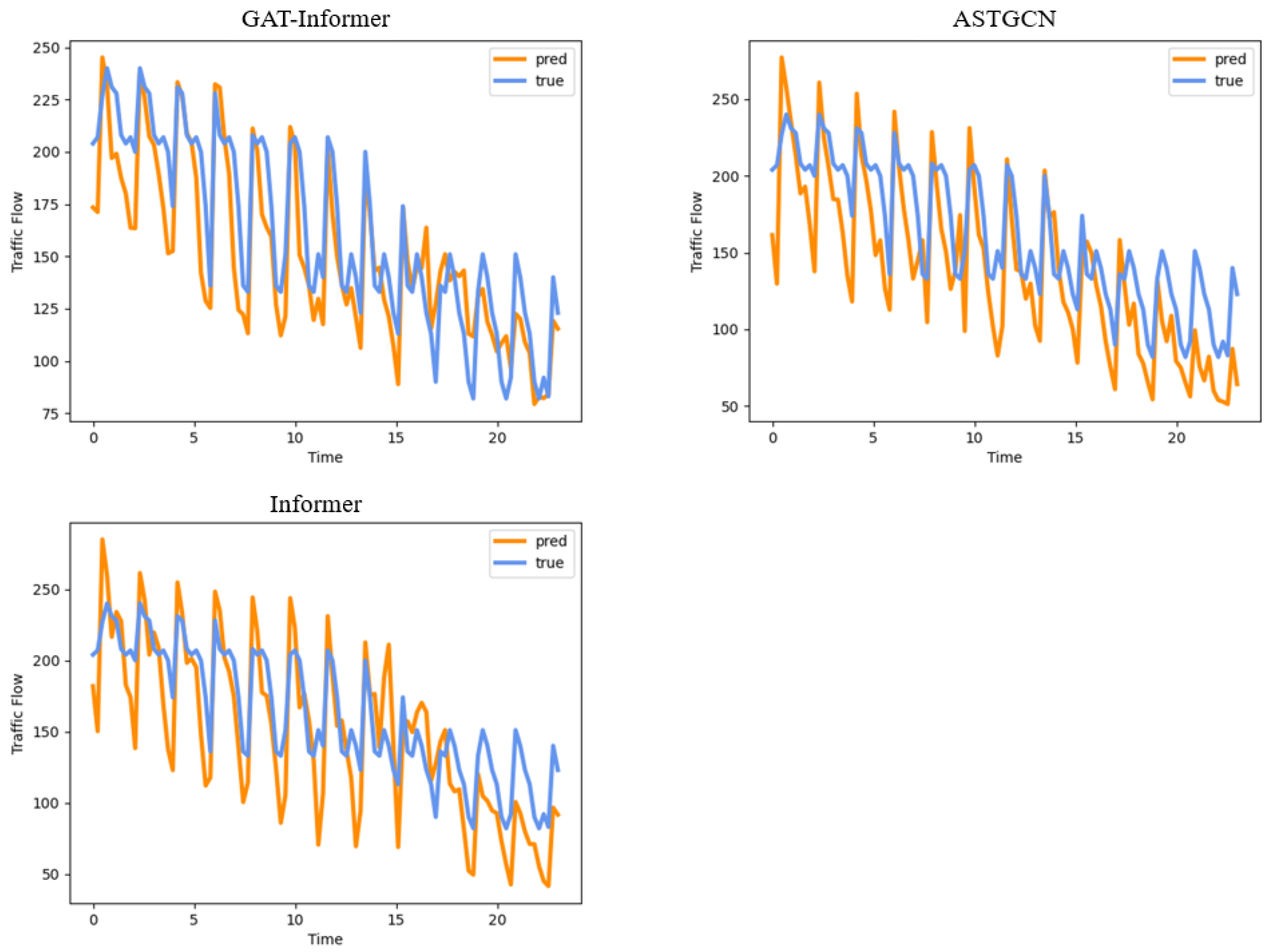
| Horizon | Criteria | GRU | T-GCN | Informer | ASTGNN | ASTGCN | GAT + Informer |
|---|---|---|---|---|---|---|---|
| 15 min | MAE | 28.04 | 23.69 | 26.27 | 25.69 | 22.40 | 21.78 |
| RMSE | 45.41 | 39.42 | 41.51 | 40.73 | 35.11 | 35.24 | |
| MAPE | 20.62 | 17.42 | 19.32 | 18.89 | 16.47 | 16.01 | |
| 30 min | MAE | 30.07 | 28.90 | 28.52 | 27.02 | 23.05 | 22.62 |
| RMSE | 47.96 | 44.76 | 46.40 | 41.49 | 35.87 | 35.36 | |
| MAPE | 21.82 | 20.34 | 20.14 | 19.23 | 17.00 | 16.98 | |
| 45 min | MAE | 30.98 | 30.21 | 29.44 | 27.81 | 23.91 | 24.21 |
| RMSE | 48.94 | 45.46 | 43.46 | 42.51 | 36.42 | 36.81 | |
| MAPE | 22.11 | 21.25 | 20.97 | 19.87 | 16.95 | 16.63 |
| Horizon | Criteria | Informer | ASTGCN | GAT + Informer | GAT + Informer * |
|---|---|---|---|---|---|
| 15 min | RMSE | 82.61 | 80.29 | 75.86 | 77.34 |
| MAE | 48.72 | 45.42 | 42.19 | 44.87 | |
| MAPE | 12.18 | 11.36 | 10.55 | 11.22 | |
| 30 min | RMSE | 86.21 | 84.65 | 81.45 | 83.56 |
| MAE | 53.65 | 49.98 | 46.22 | 48.08 | |
| MAPE | 13.41 | 12.50 | 11.56 | 12.02 | |
| 45 min | RMSE | 92.07 | 87.65 | 85.20 | 89.77 |
| MAE | 55.80 | 53.37 | 51.52 | 53.40 | |
| MAPE | 13.95 | 13.34 | 12.88 | 13.35 | |
| 60 min | RMSE | 94.83 | 93.82 | 89.82 | 91.26 |
| MAE | 60.74 | 58.27 | 56.01 | 57.71 | |
| MAPE | 15.19 | 14.57 | 14.00 | 14.43 | |
| 90 min | RMSE | 112.96 | 104.16 | 100.63 | 103.09 |
| MAE | 72.44 | 65.46 | 62.63 | 63.17 | |
| MAPE | 18.11 | 16.37 | 15.66 | 15.79 | |
| 120 min | RMSE | 117.88 | 107.06 | 105.30 | 106.68 |
| MAE | 76.11 | 67.37 | 65.85 | 66.52 | |
| MAPE | 19.03 | 16.84 | 16.46 | 16.63 |
| Horizon | Criteria | 10 min | 20 min | 30 min | 40 min |
|---|---|---|---|---|---|
| 30 min | MAE | 49.25 | 48.46 | 48.08 | 49.09 |
| RMSE | 84.98 | 84.40 | 83.56 | 84.65 | |
| MAPE | 12.31 | 12.12 | 12.02 | 12.27 | |
| 60 min | MAE | 56.20 | 56.51 | 57.71 | 56.35 |
| RMSE | 92.11 | 91.39 | 91.26 | 92.17 | |
| MAPE | 14.05 | 14.13 | 14.43 | 14.09 | |
| 90 min | MAE | 64.04 | 63.12 | 63.17 | 64.20 |
| RMSE | 100.88 | 100.52 | 103.09 | 101.02 | |
| MAPE | 16.01 | 15.78 | 15.79 | 16.05 | |
| 120 min | MAE | 68.87 | 65.87 | 66.52 | 66.62 |
| RMSE | 109.05 | 106.81 | 105.30 | 106.66 | |
| MAPE | 18.58 | 16.47 | 16.63 | 16.66 |
Disclaimer/Publisher’s Note: The statements, opinions and data contained in all publications are solely those of the individual author(s) and contributor(s) and not of MDPI and/or the editor(s). MDPI and/or the editor(s) disclaim responsibility for any injury to people or property resulting from any ideas, methods, instructions or products referred to in the content. |
© 2024 by the authors. Licensee MDPI, Basel, Switzerland. This article is an open access article distributed under the terms and conditions of the Creative Commons Attribution (CC BY) license (https://creativecommons.org/licenses/by/4.0/).
Share and Cite
Song, Y.; Luo, R.; Zhou, T.; Zhou, C.; Su, R. Graph Attention Informer for Long-Term Traffic Flow Prediction under the Impact of Sports Events. Sensors 2024, 24, 4796. https://doi.org/10.3390/s24154796
Song Y, Luo R, Zhou T, Zhou C, Su R. Graph Attention Informer for Long-Term Traffic Flow Prediction under the Impact of Sports Events. Sensors. 2024; 24(15):4796. https://doi.org/10.3390/s24154796
Chicago/Turabian StyleSong, Yaofeng, Ruikang Luo, Tianchen Zhou, Changgen Zhou, and Rong Su. 2024. "Graph Attention Informer for Long-Term Traffic Flow Prediction under the Impact of Sports Events" Sensors 24, no. 15: 4796. https://doi.org/10.3390/s24154796
APA StyleSong, Y., Luo, R., Zhou, T., Zhou, C., & Su, R. (2024). Graph Attention Informer for Long-Term Traffic Flow Prediction under the Impact of Sports Events. Sensors, 24(15), 4796. https://doi.org/10.3390/s24154796






